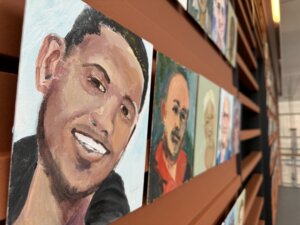In more than 200 paintings, a tribute to the spirit of the Israeli hostages
An exhibit at Philadelphia’s Weitzman Museum portrays the diversity of those held captive in Gaza

The exhibit at the Weitzman Museum features the work of eight Philadelphia women artists. Courtesy of The Weitzman Museum
Philadelphia artist Sivia Katz Braunstein was staying on a kibbutz on Oct. 7, visiting her sister and celebrating Simchat Torah. At 6 a.m., her sister woke her and said to go immediately to the safe room, where she ended up staying for two days; she could hear the Iron Dome intercepting missiles, but didn’t learn the extent of the atrocities until she returned to the US that Friday.
Back home, as she watched people tearing posters of hostages off walls, she turned to art to deal with her own trauma and to come to terms with the large-scale pain and loss of Oct. 7. She had the idea to paint the portraits of all of the hostages. The Hostage Family Forum obtained photos from the families of each hostage to make the posters, and Braunstein used these same photos to start making paintings and reached out to other Philadelphia women artists to join her in the project.
Braunstein is one of eight artists featured in “Their Portraits: Philadelphia Artists Honor October 7 Hostages,” at the Weitzman National Museum of American Jewish History in Philadelphia. The colorful 8 x 10 inch paintings convey the joy and palpable energy of their subjects before they became hostages on Oct. 7.
“It just seemed like the obvious thing for me to start painting these people — to get a handle on it and connect with them, to connect with what my sisters and the rest of my family and the rest of the country is going through over there,” Braunstein told me. “Then as the antisemitic attacks started happening I did it as outreach — to say these are human beings, look what they are going though-they are attacked, and scared, and suffering.”

Of the 200-plus hostage portraits, Braunstein herself has painted more than 80. “I am hopeful people will see the [hostages’] humanity and their diversity — the ages and races and countries they come from and different backgrounds and everyone coming together; it is startling in their diversity.”
She sees these paintings as a way “to get people to understand who these people are and to connect with them and also to have Israelis understand that we have not forgotten them.”
“I wanted to make them alive,” said Deborah Morris Zakheim who painted between 40 and 50 of the portraits. “I wanted to capture them in the moment I imagined before this happened — you are living your ordinary life doing your ordinary things and you wake up in the morning and everything changes irrevocably.”
Zakheim relates this project to the making of the AIDS quilt. “We created a display of people that had horrendous things happen to them; they still are,” she said. “Unless that quilt was created, people wouldn’t have thought of the enormity of what happened with AIDS and found a way to resolve it. People now live with AIDS; we need to figure out how to live in peace.”
“I am hoping people are reminded these are people just like them, imagine themselves being in that spot,” Zakheim continued. “They didn’t ask for any of that. They didn’t volunteer to be taken to Gaza. To me it’s a way for keeping what happened to Israel alive and front and center which is very hard to do right now.”
Unlike the ubiquitous hostage posters that have been affixed to bulletin boards and city poles, these cannot be easily torn down or vandalized. The portraits fit well in Weitzman Museum, physically and figuratively. Permanent exhibits in the museum tell the story of Jews experiencing suffering in the Holocaust, seeking freedom in the US, and creating a homeland in Israel.
Braunstein expressed hope these portraits can go to Israel to those hostage families who want them. Until then, though, I hope the paintings can stay together, if not here, in another place where the public — Jews and non-Jews–will see them — a testament, a collective cry to look in the eyes of these men, women and children and to not forget them. People need to see these paintings in their entirety so, as Zakheim says, “that people don’t forget how this all started.”
“Their Portraits: Philadelphia Artists Honor October 7 Hostages,” is being exhibited at the Weitzman National Museum of American Jewish History in Philadelphia until April 14.




















